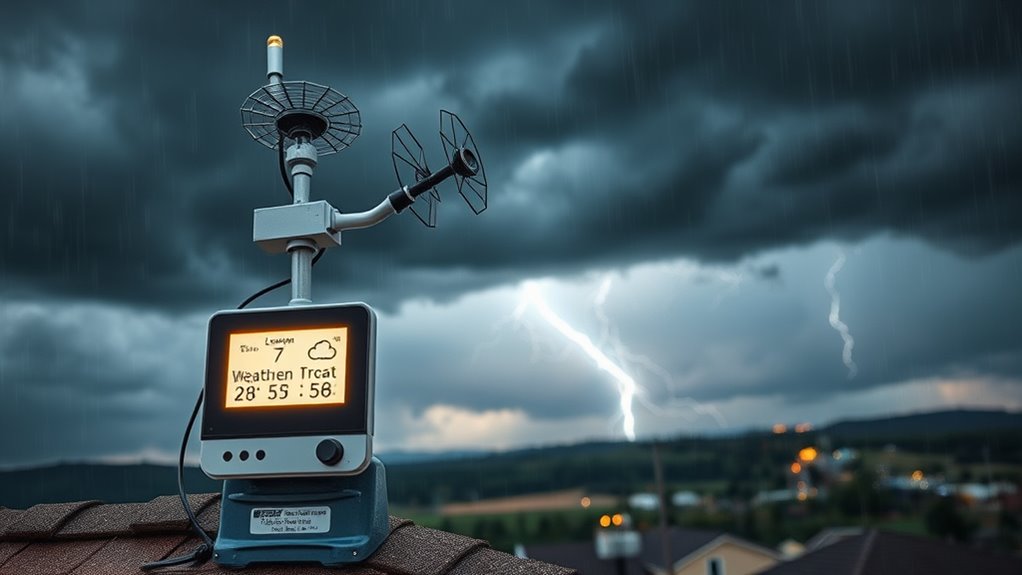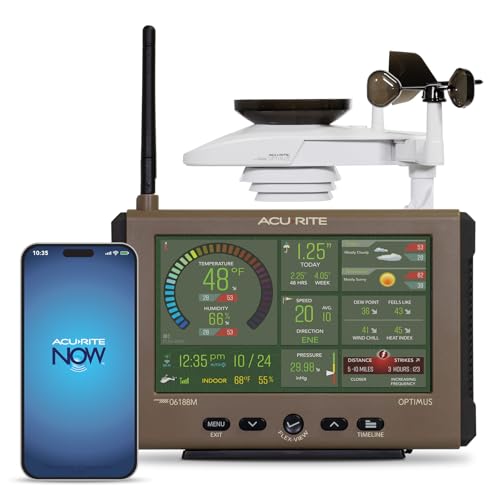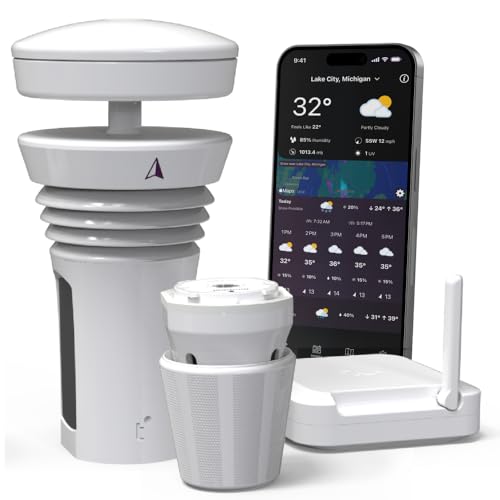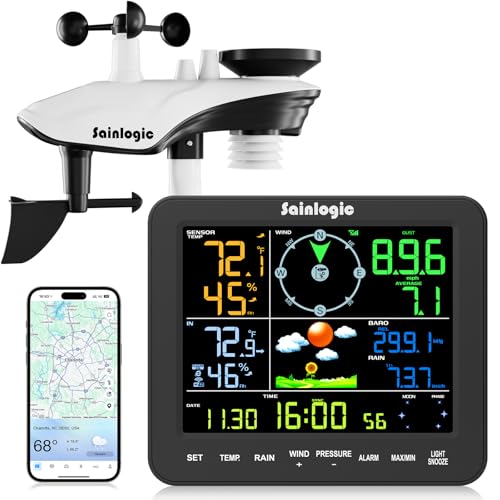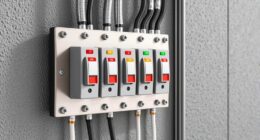If you’re looking for the top Wi-Fi weather stations with lightning detection, I recommend checking out models like AcuRite Atlas, Tempest, and Ambient Weather WS-1965, which provide real-time, hyperlocal data, storm alerts, and smart home integration. These stations offer accurate outdoor sensors, durable weatherproof designs, and easy Wi-Fi connectivity to track weather and lightning activity from anywhere. Stay tuned to discover more about these innovative options to enhance your home safety and outdoor planning.
Key Takeaways
- Features real-time hyperlocal weather data, including lightning strike detection within a 25-mile radius.
- Supports wireless Wi-Fi connectivity for remote monitoring, alerts, and smart home integration.
- Equipped with durable, weatherproof sensors and high-resolution displays for easy data visualization.
- Ideal for storm tracking, safety alerts, outdoor activities, and long-term weather analysis.
- Includes advanced calibration, historical data storage, and compatibility with platforms like Alexa and Google Home.
AcuRite Atlas Weather Station with Wi-Fi and Sensors
If you’re serious about tracking detailed weather data from anywhere, the AcuRite Atlas Weather Station with Wi-Fi and Sensors is an excellent choice. It provides real-time measurements of indoor and outdoor temperature, humidity, wind speed, direction, rainfall, UV, and light intensity. With over 20 data points, a built-in barometer, and lightning detection up to 25 miles away, it helps me anticipate storms and protect my property. The high-definition, auto-dimming display is versatile—viewable from any angle and easily mounted indoors or outdoors. Plus, remote access via Wi-Fi and the My AcuRite app makes monitoring simple, wherever I am.
Best For: outdoor enthusiasts, homeowners, and weather hobbyists who need comprehensive, real-time weather monitoring with remote access and storm prediction capabilities.
Pros:
- Provides detailed real-time data on temperature, humidity, wind, rainfall, UV, and light intensity.
- Includes lightning detection up to 25 miles away for storm anticipation.
- Supports Wi-Fi connectivity and remote monitoring via the My AcuRite app for convenience.
Cons:
- Setup may require some technical familiarity, especially for integration with weather networks.
- The display, while high-definition, may be less visible in direct bright sunlight without adjustments.
- Limited to a one-year warranty, which may not cover long-term durability concerns.
AcuRite Optimus Weather Station with Wi-Fi HD Display
The AcuRite Optimus Weather Station with Wi-Fi HD Display is an ideal choice for weather enthusiasts who want real-time, accurate data at their fingertips. Its sleek, compact design fits well in apartments, backyards, or decks, and the high-definition LCD makes readings easy to see. It measures temperature, humidity, rainfall, wind speed, wind direction, and lightning, providing extensive weather info. With seamless integration to smart-home devices like Alexa and Google Home, it enables automation based on weather conditions. The station’s durable construction and internal aspirating fan ensure reliable readings, while the AcuRite app keeps me updated with alerts and historical data wherever I go.
Best For: outdoor weather enthusiasts and smart-home integrators seeking real-time, accurate weather data with reliable connectivity and sleek design.
Pros:
- Offers comprehensive 6-in-1 weather measurements including lightning detection.
- Seamlessly integrates with smart-home devices like Alexa and Google Home for automation.
- Durable, automotive-grade construction with an internal aspirating fan for high accuracy.
Cons:
- May require Wi-Fi setup which could be complex for some users.
- The display, while high-definition, may be small for some viewing preferences.
- Cost could be higher compared to basic weather stations with fewer features.
AcuRite Iris 5-in-1 Weather Station with LCD Display
Designed for weather enthusiasts and serious home users, the AcuRite Iris 5-in-1 Weather Station with LCD Display delivers thorough real-time data that covers indoor and outdoor conditions. It tracks over 50 weather points, including temperature, humidity, wind speed/direction, barometric pressure, rainfall, and lightning strikes within 25 miles. The station features a color LCD display with auto-dimming, showing current weather, time, and alerts. Its advanced sensors and self-calibrating barometric technology enhance forecast accuracy. With support for additional sensors, wireless Bluetooth connectivity, and historical data logging, it provides comprehensive, precise insights for home, garden, or remote locations.
Best For: weather enthusiasts, serious home users, and those needing comprehensive real-time weather data for home, garden, RV, or remote locations.
Pros:
- Provides extensive coverage with over 50 weather points including temperature, humidity, wind, pressure, rainfall, and lightning detection.
- Features an easy-to-read color LCD display with auto-dimming and programmable alerts for convenience.
- Supports additional sensors and offers wireless Bluetooth connectivity for expanded monitoring options.
Cons:
- Requires 6 AA batteries, which may need frequent replacement depending on usage.
- Some features, such as additional sensors, are sold separately, potentially increasing overall cost.
- Setup and calibration can take up to 33 days for barometric accuracy, which may be time-consuming for immediate use.
AcuRite Iris Wireless Weather Station with HD Wi-Fi Display
For outdoor enthusiasts and homeowners who want instant access to hyperlocal weather data, the AcuRite Iris Wireless Weather Station with HD Wi-Fi Display offers a compelling solution. Its vibrant color display, with a fold-out stand, makes it easy to view indoor and outdoor conditions at a glance, including temperature, humidity, wind, rainfall, and barometric pressure. It predicts weather up to 12 hours ahead using in-sensor data. With Wi-Fi connectivity, I can access real-time updates and alerts via the My AcuRite app, even remotely. Plus, the lightning sensor warns me of strikes up to 25 miles away, helping me stay safe during thunderstorms.
Best For: outdoor enthusiasts and homeowners seeking instant, hyperlocal weather updates with easy remote access and safety alerts.
Pros:
- Vibrant HD color display with fold-out stand for easy viewing indoors and outdoors
- Real-time comprehensive weather data including lightning detection and 12-hour forecast
- Wi-Fi connectivity allows remote monitoring and integration with Weather Underground and the My AcuRite app
Cons:
- Requires a stable 2.4 GHz Wi-Fi connection for optimal performance
- External sensors need proper placement and maintenance for accurate readings
- The device’s full feature set may involve a learning curve for new users
Tempest Weather System with Wind Meter, Rain Gauge & Alexa Support
Are you looking for a weather station that offers hyper-local, highly accurate data to optimize your outdoor activities or home automation? The Tempest Weather System delivers just that, trusted by over 85,000 users and featured in major publications. It monitors temperature, humidity, wind, rain, lightning, and more, updating every 3 seconds with wireless, solar-powered sensors. Its seamless integration with Alexa and smart home platforms allows automation of lights, sprinklers, and thermostats based on real-time weather. Easy to install and supported by proprietary machine learning for precise forecasts, the Tempest system makes detailed home weather monitoring simple and reliable.
Best For: outdoor enthusiasts, smart home integrators, and homeowners seeking hyper-local, accurate weather data for automation and activity planning.
Pros:
- Provides real-time, hyper-local weather updates with data every 3 seconds
- Seamless integration with Alexa, IFTTT, and other smart home platforms for automation
- Durable, solar-powered outdoor sensor with wireless transmission up to 1,000+ feet
Cons:
- May require initial setup via WiFi and app configuration, which could be complex for some users
- Higher price point compared to basic weather stations
- Reliance on proprietary technology and cloud services may affect long-term support and updates
Ambient Weather WS-2902 WiFi Smart Weather Station
If you want hyper-local weather data that’s accurate and easy to access, the Ambient Weather WS-2902 WiFi Smart Weather Station is an excellent choice. It comes with an Osprey Sensor Array that measures wind speed, direction, temperature, humidity, rainfall, UV, and solar radiation. The bright, easy-to-read LCD color display makes monitoring simple. It connects wirelessly via Wi-Fi, transmitting data to the Ambient Weather Network, and supports smart home integration with Alexa, Google Home, and IFTTT. You can share data, customize your dashboard, and receive alerts remotely. Powered by three AAA batteries and mounted easily with the included pole, it’s perfect for backyard weather tracking.
Best For: homeowners, backyard enthusiasts, and weather hobbyists seeking accurate, hyper-local weather monitoring with smart home integration.
Pros:
- Comprehensive sensor array measuring wind, rain, UV, solar radiation, temperature, and humidity
- Easy-to-read color LCD display for quick monitoring
- Wireless Wi-Fi connectivity supports data sharing and smart home automation
Cons:
- Requires 3 AAA batteries (not included) for power
- Assembly and installation may require some technical setup
- Limited to Wi-Fi range; performance depends on home Wi-Fi network stability
AcuRite Iris 5-in-1 Weather Station with HD Display
The AcuRite Iris 5-in-1 Weather Station with HD Display stands out for its real-time, hyperlocal weather data, making it ideal for weather enthusiasts and outdoor hobbyists who want detailed insights right at home. It captures outdoor and indoor conditions like temperature, humidity, wind speed, rainfall, and barometric pressure, storing up to a year of high and low records. Its self-calibrating technology provides personalized 12-hour forecasts, while lightning detection within 25 miles tracks storm activity, strikes, and distance. The high-resolution, auto-dimming display shows current conditions, historical data, and time, all easily accessible. Rugged, weatherproof, and straightforward to install, it’s a all-encompassing weather monitoring solution.
Best For: outdoor weather enthusiasts, hobbyists, and homeowners seeking detailed, real-time hyperlocal weather data and storm tracking at home.
Pros:
- Provides comprehensive real-time data on outdoor and indoor conditions, including wind, rainfall, and barometric pressure.
- Features advanced lightning detection within a 25-mile radius with strike tracking and alerts.
- High-definition, auto-dimming display with easy access to current conditions, historical records, and time functions.
Cons:
- Requires installation of outdoor sensors, which may be challenging in certain environments.
- Limited wireless range of up to 100 meters, potentially restricting placement options.
- The one-year limited warranty may be insufficient for long-term peace of mind.
Sainlogic WiFi Smart Weather Station with 8.5″ Display
The Sainlogic WiFi Smart Weather Station with an 8.5-inch display is ideal for outdoor enthusiasts and professionals who need accurate, real-time weather data at a glance. It offers WiFi connectivity (only 2.4G) and uses the Weatherseed App for instant updates, alerts, and forecasts. The station includes a large, easy-to-read display and a 7-in-1 outdoor sensor that monitors temperature, humidity, rainfall, wind, UV, and sunlight. Its wireless range extends up to 330 feet, making it suitable for various outdoor spaces. Power options include solar energy and a battery backup (not included). Data is stored for up to two years, with export options for detailed analysis.
Best For: outdoor enthusiasts, farmers, and professionals who require accurate, real-time weather data and detailed long-term analysis.
Pros:
- Large 8.5-inch display with clear, easy-to-read data visualization
- Comprehensive weather monitoring with 7-in-1 outdoor sensor covering multiple parameters
- Wireless range of up to 330 feet suitable for various outdoor environments
Cons:
- Only supports 2.4G WiFi, limiting compatibility with dual-band networks
- Battery backup requires batteries (not included), adding to initial setup costs
- Data storage limited to two years, which may be insufficient for long-term archival needs
Sainlogic WiFi Weather Station with Rain Gauge and Wind Speed
Designed with ease of use in mind, the Sainlogic WiFi Weather Station with Rain Gauge and Wind Speed is ideal for gardeners, farmers, and outdoor enthusiasts who want reliable, real-time weather data without complicated setup. Connecting wirelessly via 2.4G WiFi to the Weatherseed app, it’s simple to install with a mounting bracket for outdoor sensors. It offers 24/7 AI-driven forecasts, instant alerts for temperature, humidity, and barometric pressure changes, and precise rainfall measurements with ±1mm accuracy. Its high-contrast display is easy to read, and data can be stored and exported for long-term analysis, making it a versatile, user-friendly tool for any outdoor environment.
Best For: gardeners, farmers, outdoor enthusiasts, and weather hobbyists seeking reliable, real-time weather data with easy setup and long-term data analysis.
Pros:
- Easy wireless setup via 2.4G WiFi with straightforward installation
- Accurate rainfall measurement with ±1mm precision and real-time alerts
- User-friendly high-contrast display suitable for all age groups
Cons:
- Limited to 2.4G WiFi network, not compatible with 5G bands
- Requires stable WiFi connection for optimal data transmission
- Outdoor sensor mounting may require additional brackets or tools for uneven surfaces
Ambient Weather WS-4000 Solar Powered UltraSonic Wi-Fi Weather Station
If you’re looking for a durable, low-maintenance weather station that offers accurate measurements and seamless remote monitoring, the Ambient Weather WS-4000 Solar Powered UltraSonic Wi-Fi Weather Station is an excellent choice. It features ultrasonic wind and haptic rain gauges with no moving parts, ensuring longevity and minimal upkeep. The all-encompassing sensors, including indoor temperature, humidity, and barometric pressure, provide detailed data. Its compact, all-in-one design makes installation effortless—no tools needed. Powered by solar energy and connected via Wi-Fi, it allows remote access through the Ambient Weather Network, plus a free one-month subscription to AWN+ for enhanced data analysis and alerts.
Best For: outdoor enthusiasts, homeowners, and professionals seeking a durable, easy-to-install weather station with comprehensive remote monitoring capabilities.
Pros:
- Ultrasonic wind and rain gauges with no moving parts for increased durability and low maintenance
- Solar-powered and Wi-Fi connected for eco-friendly operation and seamless remote access
- All-in-one, compact design allows quick and tool-free installation in any location
Cons:
- Requires Wi-Fi connectivity for remote features, which may be limited in areas with poor internet service
- Subscription to AWN+ is optional but enhances features; without it, data analysis options are limited
- Indoor sensor measurements depend on proper placement and calibration for accuracy
Ambient Weather WS-2000 Smart Weather Station with WiFi Remote Monitoring and Alerts
For anyone looking to keep a close eye on their local weather conditions with ease, the Ambient Weather WS-2000 offers an all-encompassing solution. It monitors wind speed and direction, temperature, humidity, rainfall, UV, and solar radiation, supporting both imperial and metric units with calibration options. The TFT color display makes it simple to view data at a glance, while the wireless sensor array provides integrated measurements. Enhanced Wi-Fi connectivity allows wireless data transmission to a large personal weather station network. With remote monitoring and real-time alerts, I can stay informed about changing weather conditions effortlessly, making it ideal for home and backyard weather tracking.
Best For: homeowners, backyard enthusiasts, or weather hobbyists seeking comprehensive, easy-to-read weather monitoring with remote access and alerts.
Pros:
- Supports monitoring of wind speed, direction, temperature, humidity, rainfall, UV, and solar radiation in one device
- Features a user-friendly TFT color display for quick data insights
- Enables wireless data transmission via Wi-Fi to a large personal weather network
Cons:
- Sensor array requires 3 AAA batteries, which are not included
- Setup and calibration may be complex for beginners unfamiliar with weather stations
- The console needs a 5V DC power adapter, which must be purchased separately if not included
Sainlogic WiFi Weather Station with App & Email Alerts
The Sainlogic WiFi Weather Station with App & Email Alerts stands out for its real-time, AI-powered weather forecasting, making it an excellent choice for outdoor enthusiasts, gardeners, and professionals who need accurate, timely updates. It provides precise alerts for temperature, humidity, and barometric pressure changes, helping users stay ahead of weather shifts. The device connects easily through 2.4GHz WiFi and supports quick setup with minimal technical skills. Its professional-grade rain monitor offers highly accurate rainfall data, ideal for meteorologists or farmers. The 8.15-inch display is user-friendly, and the station stores weather data for up to two years, perfect for long-term analysis.
Best For: outdoor enthusiasts, gardeners, and professionals seeking accurate, real-time weather data with long-term analysis capabilities.
Pros:
- Easy setup via 2.4GHz WiFi with minimal technical skills required
- Professional-grade rain monitor with highly accurate rainfall measurements
- Large, high-contrast display with user-friendly interface suitable for all ages
Cons:
- Limited to 2.4GHz WiFi connectivity, incompatible with 5GHz networks
- Outdoor sensors may require secure mounting and weatherproofing for optimal performance
- Data storage is up to two years, which may be insufficient for some long-term research needs
AcuRite Iris 5-in-1 Home Weather Station with Wi-Fi
The AcuRite Iris 5-in-1 Home Weather Station with Wi-Fi stands out as an ideal choice for weather enthusiasts who want hyperlocal, real-time data accessible from anywhere. It provides detailed indoor and outdoor measurements, including temperature, humidity, wind speed and direction, barometric pressure, and rainfall, using multiple sensors. The large color LCD display shows current conditions, time, and date, with adjustable brightness for easy reading. Its Wi-Fi connectivity allows seamless data sharing with Weather Underground, supporting remote access and real-time updates. Recognized for quality and ease of use, it’s a reliable, all-inclusive tool for accurate home weather monitoring.
Best For: weather enthusiasts and homeowners seeking hyperlocal, real-time weather data accessible remotely via Wi-Fi for accurate indoor and outdoor monitoring.
Pros:
- Provides comprehensive weather data including temperature, humidity, wind, pressure, and rainfall with multiple sensors.
- Large, adjustable color LCD display offers easy readability of current conditions, time, and date.
- Seamless Wi-Fi connectivity enables remote access, data sharing with Weather Underground, and real-time updates.
Cons:
- Requires initial setup and proper mounting of outdoor sensors, which may be challenging for some users.
- Dependence on Wi-Fi connection; performance may be affected by network issues.
- May be more expensive compared to basic weather stations without smart features.
Sainlogic Wireless Weather Station with Rain Gauge and Wind Speed
If you’re seeking a reliable weather station that’s easy to set up and offers precise outdoor measurements, the Sainlogic Wireless Weather Station with Rain Gauge and Wind Speed is an excellent choice. It features a 6.5-inch HD color LCD screen with high-contrast visuals, oversized fonts, and adjustable backlight for clear reading in any lighting. Installation is straightforward—mount the outdoor sensor on fences, roofs, or piers and sync wirelessly. It provides real-time data on indoor and outdoor temperature, humidity, barometric pressure, wind speed, rainfall, and more. With a 330-foot wireless range, it ensures stable connectivity over large areas, ideal for home, farm, or garden monitoring.
Best For: DIY enthusiasts, homeowners, and environmental monitors seeking an easy-to-install, accurate weather station with comprehensive outdoor measurement capabilities.
Pros:
- Easy installation with wireless setup, no complicated wiring required
- Clear 6.5-inch HD color LCD display with adjustable backlight for easy readability
- Reliable 330-foot wireless range ensures stable connectivity over large outdoor areas
Cons:
- Requires batteries or power source for outdoor sensors (not specified)
- Limited WiFi functionality, so data cannot be accessed remotely via internet
- May have limited advanced features compared to high-end smart weather stations
Ambient Weather WS-1965 WiFi Weather Station
For anyone seeking a thorough weather monitoring solution, the Ambient Weather WS-1965 WiFi Weather Station stands out with its all-in-one sensor array and color LCD display. It measures temperature, humidity, barometric pressure, wind speed, wind direction, and rainfall, updating data every 16 seconds in real time. Its enhanced WiFi supports wireless data transmission, allowing remote access via the Ambient Weather Network. Compatible with IFTTT, Google Home, and Alexa, it enables alerts and automation. Plus, you can customize your dashboard, share hyperlocal weather conditions, and create forecasts. This reliable system is suitable for both personal and professional use, delivering accurate, real-time weather insights.
Best For: outdoor enthusiasts, homeowners, and professionals seeking comprehensive, real-time weather monitoring with smart home integration.
Pros:
- All-in-one sensor array with color LCD display for easy reading of multiple weather parameters
- Supports wireless WiFi transmission for remote access and real-time updates every 16 seconds
- Compatible with smart home platforms like IFTTT, Google Home, and Alexa for automation and alerts
Cons:
- May require technical setup for network connectivity and integration
- Limited customization options for advanced users without additional software tools
- Higher price point compared to basic weather stations with fewer features
Factors to Consider When Choosing Wi‑Fi Weather Stations With Lightning Detection
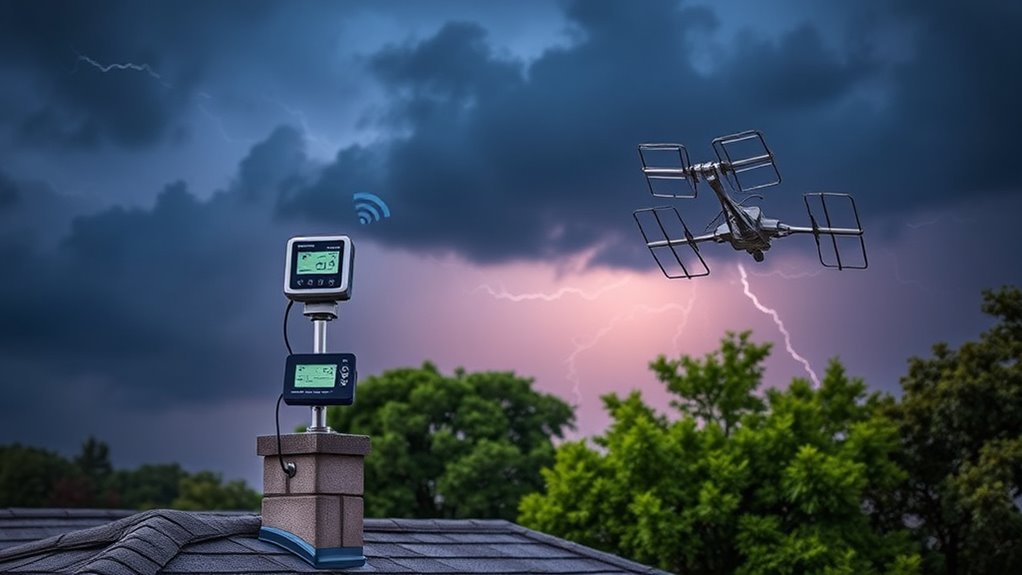
When selecting a Wi-Fi weather station with lightning detection, I consider factors like detection range and data accuracy to guarantee reliable alerts. Wireless signal strength and sensor durability also matter, especially in harsh weather conditions. Ultimately, I look for app compatibility and alert features that make monitoring simple and effective.
Lightning Detection Range
Lightning detection range is a crucial factor to contemplate because it determines how early you can receive storm alerts. Typically, the range varies from 10 to 25 miles, affecting how much advance warning you get. A longer detection radius means you can act sooner, giving you more time to take safety precautions. The effectiveness of detection relies heavily on sensor sensitivity and quality, so higher-quality lightning sensors can extend the range. However, detecting strikes at greater distances might also lead to false alarms from distant or non-threatening lightning. Understanding this range helps me select a weather station that offers reliable alerts tailored to my outdoor environment. Ultimately, a suitable detection radius ensures I stay informed without unnecessary alerts, enhancing my safety and peace of mind.
Data Accuracy Levels
Choosing a Wi-Fi weather station with reliable lightning detection depends heavily on data accuracy. The key to dependable readings lies in high-quality sensors—thermometers, hygrometers, and anemometers—that are well-calibrated and maintained. Lightning detection accuracy hinges on sensor sensitivity, which typically detects strikes within 25 miles, aiding storm tracking. The precision of wind speed and rainfall measurements depends on sensor design, with ultrasonic technology offering more consistent results than mechanical parts. Environmental factors like electromagnetic interference, obstructions, and sensor placement can introduce errors, so proper positioning is vital. Regular calibration and validation against professional instruments ensure ongoing accuracy. Ultimately, a station’s ability to deliver precise data hinges on sensor quality, calibration, and how well environmental influences are managed.
Wireless Signal Strength
A strong Wi-Fi signal is essential for ensuring reliable data transmission between your outdoor weather sensors and indoor display. When the signal is weak, data can be lost or delayed, affecting real-time weather updates and lightning alerts. Obstacles like walls, trees, or metal structures can weaken connectivity, so ideal placement of the outdoor sensor is crucial—ideally within the recommended wireless range, often up to 330 feet. Most weather stations operate on the 2.4 GHz band, which provides better range but can be more prone to interference from other devices. Regularly checking and optimizing your Wi-Fi signal quality helps prevent disruptions, ensuring consistent weather monitoring and lightning detection. Clear, strong connectivity makes your weather station more reliable and effective.
Sensor Durability & Weatherproofing
Since weather conditions can be unpredictable, guaranteeing your Wi-Fi weather station’s sensors are durable and weatherproof is essential for long-term reliability. Look for stations with weatherproof housings that can withstand rain, snow, and UV exposure, preventing damage over time. Sensors made from corrosion-resistant materials like treated plastics or stainless steel maintain performance in harsh outdoor environments. Sealed, airtight enclosures are vital to prevent moisture from entering and damaging electronics. Additionally, waterproof gaskets or covers on cables and ports help preserve sensor integrity. Reinforced mounting brackets and shock-absorbing options are also important, as they protect the sensors from strong winds and impacts. Prioritizing these features ensures your weather station remains accurate and functional, no matter the weather.
App Compatibility & Alerts
Ever wondered if your weather station’s app can keep up with storm alerts? Compatibility is key—make sure the app works seamlessly on your smartphone’s OS, whether iOS or Android. You want real-time lightning alerts that are customizable, so you can set thresholds and stay ahead of severe weather. Reliable notifications are essential, so check if alerts come via push notifications, emails, or SMS—multiple channels ensure you don’t miss critical updates. A good app also offers historical data and trend analysis, helping you understand storm patterns over time. Finally, confirm that configuring alert thresholds for lightning activity and other weather events is straightforward. This way, you stay informed and prepared, no matter what Mother Nature throws your way.
Ease of Installation
When selecting a Wi-Fi weather station with lightning detection, ease of installation should be a top consideration. Look for models that come with clear, detailed instructions to avoid confusion during setup. Choose stations with outdoor sensors that offer simple mounting options, like brackets or stands, to save time. Opt for devices with minimal wiring and strong wireless connectivity, which simplifies the process and reduces hassle. Guarantee the setup process supports quick calibration and initial configuration through a user-friendly app or interface. Additionally, check if the station provides extensive support resources, such as manuals and customer service, in case you need assistance. Prioritizing easy installation helps you get your weather station up and running quickly and accurately, with less frustration.
Power Source Options
Choosing the right power source for your Wi-Fi weather station with lightning detection is essential for reliable performance and installation flexibility. Many models use AC adapters, but some offer rechargeable batteries or solar panels, providing greater independence. Battery-powered options ensure continuous monitoring during power outages and allow for portability, which is helpful if you want to move the station around. Solar-powered models use photovoltaic panels to recharge internal batteries, making them ideal for remote, outdoor setups without reliable electricity. Hybrid systems combine solar energy with battery backups, offering enhanced reliability and resilience. Your choice impacts installation options, operational costs, and how well the station maintains lightning detection during power interruptions. Selecting the appropriate power source depends on your location, installation preferences, and long-term monitoring needs.
Price & Warranty Coverage
Price and warranty coverage are critical factors to contemplate when selecting a Wi-Fi weather station with lightning detection, as they directly impact your overall investment and peace of mind. First, consider the total cost, including any extra sensors or accessories necessary for lightning detection features. It’s also important to check if the product offers a thorough warranty, typically between one and three years, to safeguard against defects. Pay special attention to whether the warranty covers lightning detection components, which may be more prone to damage. Review the manufacturer’s policy for details on parts, labor, and if accidental damage is included. Finally, ensure the warranty process for claims, repairs, or replacements is straightforward, so you’re not left uncertain during critical moments.
Frequently Asked Questions
How Accurate Are Lightning Detection Features in These Weather Stations?
Lightning detection features in these weather stations are generally quite accurate, especially within a certain radius. I’ve found they can detect nearby strikes reliably, giving timely alerts to keep my home safe. However, their accuracy drops with distance or weather conditions like heavy rain or storms. Overall, I trust these features for early warnings, but I always stay vigilant and use multiple sources for critical safety decisions.
Can These Stations Differentiate Between Various Types of Lightning Strikes?
Did you know that most advanced lightning detection systems can identify over 90% of nearby lightning strikes? These stations typically can differentiate between cloud-to-ground and intra-cloud strikes, giving you a clearer picture of storm activity. I’ve found that while they’re quite effective, some models may struggle with pinpointing the exact type of strike in complex weather conditions. Still, they’re invaluable for staying safe and informed during storms.
Do Wi-Fi Weather Stations Require Professional Installation for Lightning Detection?
No, Wi-Fi weather stations with lightning detection generally don’t require professional installation. I set mine up myself by placing it in an open, elevated spot away from obstructions, following the manufacturer’s instructions. It’s straightforward and usually involves connecting to Wi-Fi and calibrating the sensors. However, if you want ideal accuracy or have a complex setup, consulting a professional might be helpful.
Are Weather Stations With Lightning Detection Suitable for Outdoor or Indoor Use?
Imagine feeling truly secure in your home—that’s what weather stations with lightning detection offer. These devices are designed primarily for outdoor use, where they can monitor weather conditions and alert you to approaching storms. While some models are rugged enough for outdoor installation, they’re generally not meant for indoor use. So, I’d recommend placing them outside in a sheltered spot to get the most accurate and reliable readings.
How Do Lightning Detection Capabilities Integrate With Home Automation Systems?
Lightning detection capabilities easily integrate with home automation systems by connecting through Wi-Fi or smart hubs. I can set up alerts to notify me instantly when lightning is detected nearby, allowing me to take quick action or adjust my smart devices accordingly. Some systems even automate responses, like turning off outdoor electronics or activating storm shutters, making my home safer and more responsive during severe weather events.
Conclusion
Choosing the right Wi-Fi weather station with lightning detection really depends on your needs. For example, I once helped a homeowner who prevented a surprise storm from damaging their garden by catching lightning early with a high-end station. Don’t underestimate the importance of reliable sensors and alerts—investing in a good system can save you time, money, and peace of mind. So, pick one that fits your monitoring goals and stay ahead of the weather!

